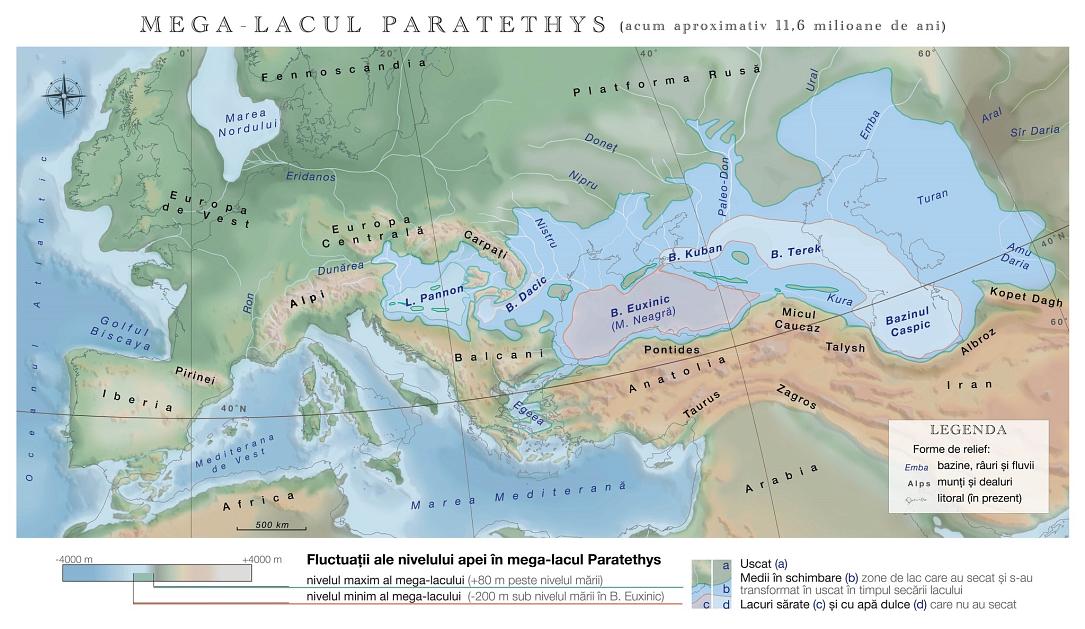Romanian researchers enter Guinness World Records after discovering largest lake in history



Romanian researchers from the National Institute for Research and Development in Geology and Marine Geoecology (GeoEcoMar) and the University of Bucharest have entered the Guinness World Records after discovering the immense proportions of the largest lake in Earth's history, Paratethys.
Formed about 12 million years ago, the largest lake known to have ever existed on Earth is named Megalake Paratethys, which extended from the eastern Alps of Europe to what is now Kazakhstan in Central Asia. At its peak around 10 million years ago, it is estimated to have covered an area of 2.8 million square kilometers (1.08 million square miles) - slightly larger than the current Mediterranean Sea - and held a volume of over 1.77 million cubic kilometers (424,645 cubic miles). Dan Palcu and his colleagues determined the proportions of the mega-lake in a study published in June 2021.
Guinness World Records has published an online article dedicated to 'The Largest Lake Ever,' and the record has also been featured in printed editions in over 40 languages.
At its peak, Paratethys covered an area of approximately 2.8 million square kilometers and contained over 1.8 million cubic kilometers of brackish water (a combination of fresh and saltwater in varying proportions). This is over ten times larger than the combined volume of all current freshwater and saltwater lakes.
The study leading to the discovery was conducted in collaboration with Utrecht University (Netherlands), University of São Paulo (Brazil), Russian Academy of Sciences (Russia), Senckenberg Biodiversity and Climate Research Centre (Germany), and the University of Bucharest (Romania), led by paleo-oceanographer Dan Palcu from the University of São Paulo.
"For a long time, it was believed that this area was a prehistoric sea, the Sarmatic Sea. Now we have clear evidence that for about five million years, this sea turned into a lake - isolated from the ocean and teeming with unique animals not found elsewhere on the globe. The lake covered much of Romania's territory, except for mountainous areas, leaving behind spectacular evidence such as the boulder-strewn sands in the Subcarpathians of Buzău and Oltenia beneath the mountains, the limestones in the Istriţa area that were tropical beaches ten million years ago, and the reddish cliffs in Southern Dobrogea, where the lake's filling and draining cycles are reflected in the alternating whitish-reddish layers of rocks," said Dan Palcu.
"Our investigations [...] reveal an ecosystem that responded dramatically to climate fluctuations. We gain invaluable information by exploring the cataclysms endured by this ancient mega-lake due to climate changes. With their help, potential ecological crises triggered by our planet's current climate changes can be elucidated. At the same time, our research provides insights into the stability of basins with toxic waters, such as the Black Sea," the researcher added.
Throughout its 5-million-year existence, a combination of climate changes and tectonic activity dramatically reduced the size of Megalake Paratethys. During its most intense desiccation period, between 7.65 and 7.9 million years ago, it lost over a third of its water and about two-thirds of its surface area, decreasing by approximately 250 meters (820 feet). A subsequent refilling of the lake is believed to have caused an overflow into the Mediterranean Sea between 6.7 and 6.9 million years ago.
Paratethys once hosted a variety of endemic fauna found nowhere else on the planet, including Cetotherium riabinini, the smallest baleen whale in the fossil record, reaching a length of about 3 meters (9 feet 10 inches).
The Black Sea, Caspian Sea, and Aral Sea, once basins in the Paratethys, are now the main remnants of the mega-lake. Dr. Palcu is researching the resilience of these ecologically fragile regions to climate change and human-induced alterations through a project funded by PNRR.
"The modern Black Sea has the potential to become one of the largest natural carbon storage regions. Its stability is of paramount importance for future carbon storage initiatives and preventing future ecological disasters," Dr. Palcu argued.
(Photo source: INCD Geoecomar on Facebook)